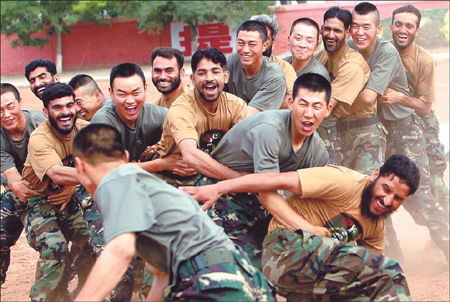
Afghani President Mohammad Ashraf Ghani. In the new foreign policy that Ghani recently outlined, the United States finds itself consigned to the third of the five "circles" of importance. (Photo: US Institute of Peace)
By Dilip Hiro
Tom Dispatch
April 1, 2015 – Call it an irony, if you will, but as the Obama administration struggles to slow down or halt its scheduled withdrawal from Afghanistan, newly elected Afghan President Ashraf Ghani is performing a withdrawal operation of his own. He seems to be in the process of trying to sideline the country’s major patron of the last 13 years — and as happened in Iraq after the American invasion and occupation there, Chinese resource companies are again picking up the pieces.
In the nineteenth century, Afghanistan was the focus of “the Great Game” between the imperial powers of that era, Britain and Czarist Russia, and so it is again. Washington, the planet’s “sole superpower,” having spent an estimated $1 trillion and sacrificed the lives of 2,150 soldiers fighting the Taliban in the longest overseas war in its history, finds itself increasingly and embarrassingly consigned to observer status in the region, even while its soldiers and contractors still occupy Afghan bases, train Afghan forces, and organize night raids against the Taliban.
In the new foreign policy that Ghani recently outlined, the United States finds itself consigned to the third of the five circles of importance. The first circle contains neighboring countries, including China with its common border with Afghanistan, and the second is restricted to the countries of the Islamic world.
In the new politics of Afghanistan under Ghani, as the chances for peace talks between his government and the unbeaten Taliban brighten, the Obama administration finds itself gradually but unmistakably being reduced to the status of bystander. Meanwhile, credit for those potential peace talks goes to the Chinese leadership, which has received a Taliban delegation in Beijing twice in recent months, and to Ghani, who has dulled the hostility of the rabidly anti-Indian Taliban by reversing the pro-India, anti-Pakistan policies of his predecessor, Hamid Karzai.
How to Influence Afghans
Within a month of taking office in late September, Ghani flew not to Washington — he made his obligatory trip there only last week — but to Beijing. There he declared China “a strategic partner in the short term, medium term, long term, and very long term.” In response, Chinese President Xi Jinping called his Afghan counterpart “an old friend of the Chinese people,” whom he hailed for being prepared to work toward “a new era of cooperation” and for planning to take economic development “to a new depth.” (Continued)
Continue reading The Great Game in Afghanistan: The US Is Losing Out…to China


